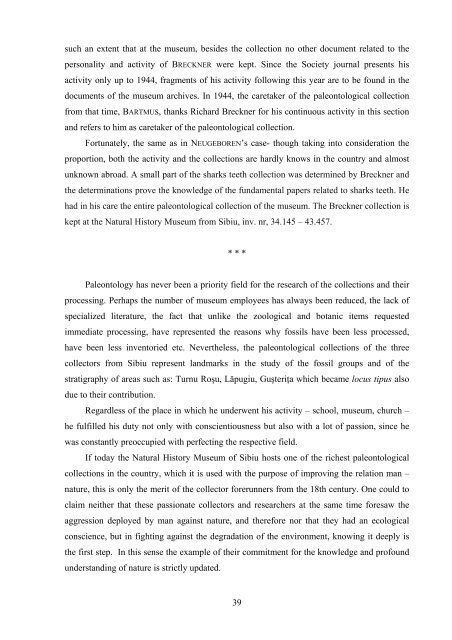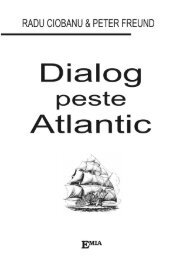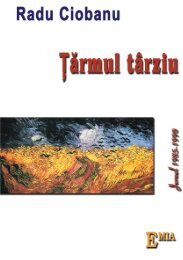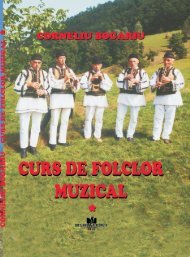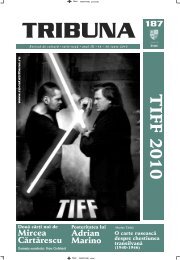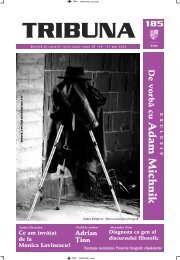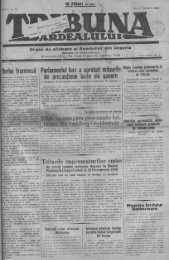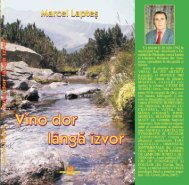such an extent that at the museum, besides the collection no other document related to thepersonality and activity of BRECKNER were kept. Since the Society journal presents hisactivity only up to 1944, fragments of his activity following this year are to be found in thedocuments of the museum archives. In 1944, the caretaker of the paleontological collectionfrom that time, BARTMUS, thanks Richard Breckner for his continuous activity in this sectionand refers to him as caretaker of the paleontological collection.Fortunately, the same as in NEUGEBOREN’s case- though taking into consideration theproportion, both the activity and the collections are hardly knows in the country and almostunknown abroad. A small part of the sharks teeth collection was determined by Breckner andthe determinations prove the knowledge of the fundamental papers related to sharks teeth. Hehad in his care the entire paleontological collection of the museum. The Breckner collection iskept at the Natural History Museum from Sibiu, inv. nr, 34.145 – 43.457.* * *Paleontology has never been a priority field for the research of the collections and theirprocessing. Perhaps the number of museum employees has always been reduced, the lack ofspecialized literature, the fact that unlike the zoological and botanic items requestedimmediate processing, have represented the reasons why fossils have been less processed,have been less inventoried etc. Nevertheless, the paleontological collections of the threecollectors from Sibiu represent landmarks in the study of the fossil groups and of thestratigraphy of areas such as: Turnu Roşu, Lăpugiu, Guşteriţa which became locus tipus alsodue to their contribution.Regardless of the place in which he underwent his activity – school, museum, church –he fulfilled his duty not only with conscientiousness but also with a lot of passion, since hewas constantly preoccupied with perfecting the respective field.If today the Natural History Museum of Sibiu hosts one of the richest paleontologicalcollections in the country, which it is used with the purpose of improving the relation man –nature, this is only the merit of the collector forerunners from the 18th century. One could toclaim neither that these passionate collectors and researchers at the same time foresaw theaggression deployed by man against nature, and therefore nor that they had an ecologicalconscience, but in fighting against the degradation of the environment, knowing it deeply isthe first step. In this sense the example of their commitment for the knowledge and profoundunderstanding of nature is strictly updated.39
The personal paleontological collections, later on donated or sold to the museum pointout the level of the paleontological research in Transylvania and especially towards the southof the depression.REFERENCESACKNER M. J. 1849-1850. Siebenbürgische Petrefacten im seiner Sammlung, Verhandlungenund Mitteilungen des siebenbürgischen Vreiens für Naturwissenschaften zuHermannstadt, in „Verhandlungen”, Sibiu, 1:150-171.BIELZ E. A. 1888. Nekrolog – Johann Ludwig Neugeboren, Verhandlungen und MitteilungenSiebenbürgische Verein für Naturwissenshaftlichen zu Hermannstadt, Sibiu, 38:1-7.CIOBANU RODICA. 1995. Colecţionari transilvăneni din sec. XVIII-XIX - precursori aiecologiştilor de astăzi, Studii şi cercetări, Muzeul Bistriţa-Năsăud, Bistriţa, 1:239-242.CIOBANU RODICA. 1996. Ludwig Johann Neugeboren (1806-1887)–paleontolog transilvăneande renume european, Convergenţe transilvane, Sibiu, 4: 9-18.CIOBANU RODICA. 1998. Colecţia de selacieni - Richard Breckner, Studii şi comunicări,Muzeul Brukenthal, Sibiu, 27:115-119.CIOBANU RODICA. 2003. Paläontologische Forschungen in der Zeitschrift “Verhandlungen”,Forschungen der Siebenbürgische Verein für Naturwissenshaftlichen zu Hermannstadt(1849-1949). Jubiläumsband, Herausgegeben von H.Heltmann, H.von Killyen, 245-261,hora Verlag Hermannstadt und Arbeitskreis für Siebenbürgische Landeskundee.V.Heidelberg.GHEORGHIAN M., GHEORGHIAN MARIA. 1968. Situaţia tipurilor de foraminifere din colecţiaNeugeboren de la Lăpugiul de Sus – Hunedoara, aflată la Muzeul Brukenthal Sibiu,Rev.Muzeelor, Bucureşti, 4:334-335.ILIE M. D. 1955. Cercetări geologice în Bazinul Transilvaniei (Regiunea Alba Iulia – Sibiu –Făgăraş – Rupea), Anuarul Comitetului Geologic, Bucureşti, 37:335.MUŞAT Gh. & CIOBANU RODICA. 1998. Piese rare în colecţiile Muzeului de istorie Naturală.Colecţia de foraminifere a lui L.J.Neugeboren şi importanţa ei, Studii şi comunicări,Muzeul Brukenthal, Sibiu, 27:67-113.MYSS W. (ed.). 1993. Lexikon der Siebenbürger Sachsen, Editura Wort und Welt, Thaur beiInnsbruk.NEUGEBOREN L. J. 1850. Die vorweltlichen Squaliden-Zähne aus dem Grobkalke bei Portsesdam Altfluβ unweit Talmats, Archiv des Verein für Siebenbürgische Landeskunde, Sibiu,4(2) :1-44; 1851, 4(3):11-213.40
- Page 2 and 3: ACTA MUSEI DEVENSISS A R G E T I AS
- Page 4 and 5: S U M M A R Y - SO M M A I R EZOLTA
- Page 6 and 7: Sargetia, Acta Mus. Dev. Ser. Sci.
- Page 8 and 9: (DINCĂ & all. 1972; ANTONESCU & al
- Page 10 and 11: western European, North American, A
- Page 12 and 13: snakes, crocodilians, pterosaurs, o
- Page 14 and 15: of previously ignored components of
- Page 16 and 17: (2) the endemic character of the as
- Page 18 and 19: of vertebrate taxa, including dinos
- Page 20 and 21: size of many dinosaurs, low diversi
- Page 22 and 23: ANTONESCU E., LUPU D. & LUPU M. 198
- Page 24 and 25: JIANU CORALIA-MARIA & BOEKSCHOTEN G
- Page 26 and 27: ROTH V. L. 1992. Inferences from al
- Page 28 and 29: Sargetia, Acta Mus. Dev. Ser. Sci.
- Page 30 and 31: Being the administrative center of
- Page 32 and 33: The main way to acquire paleontolog
- Page 34 and 35: The collecting activity, started in
- Page 36 and 37: the fossil area from Turnu Roşu is
- Page 38 and 39: The year 1840 represents the beginn
- Page 42 and 43: NEUGEBOREN J. L. 1851. Zur vortwelt
- Page 44 and 45: (1862 m). La rivière de Strei est
- Page 46 and 47: echerches ichtyologiques effectuée
- Page 48 and 49: droite. Dans quelques endroits de l
- Page 50 and 51: Turdaş, Simeria Veche. Leur décle
- Page 52 and 53: (janvier-mars), les précipitations
- Page 54 and 55: hydrotechniques de la rivière de R
- Page 56 and 57: Les eaux sont bicarbonate-calciques
- Page 58 and 59: avec un caractère collinaire, le S
- Page 60 and 61: Fig. 3 - 4: Aunaies dans la valée
- Page 62 and 63: PETERFI L., BOŞCAIU N. & CERNELEA
- Page 64 and 65: 5040%302041,820,81016,6112,82,84,20
- Page 66 and 67: mésohygrophyte (27,6%), micro-meso
- Page 68 and 69: La strate herbacée réalisant des
- Page 70 and 71: dans leur majorité caractéristiqu
- Page 72 and 73: Carex digitata +Carex pilosa +Actae
- Page 74 and 75: Ec10%sM5%P Cosm4% 2%Cp4%E25%Eua50%P
- Page 76 and 77: Ec8%sM1%B1%Cosm1%Cp1%Eua49%E30%Prun
- Page 78 and 79: Ec6%sM Md2% 1%Cosm6%Cp10%E19%Eua56%
- Page 80 and 81: Le tapis végétal est pas bien dev
- Page 82 and 83: Echium vulgare +Campanula patula +C
- Page 84 and 85: Le spectre floristique de cette ass
- Page 86 and 87: Du point de vue floristique, les é
- Page 88 and 89: Agrostis canina + - +Brachypodium s
- Page 90 and 91:
Stellaria graminea + + +Ranunculus
- Page 92 and 93:
Elymus repens + 1.1 1Festuca rubra
- Page 94 and 95:
espèces acidifiés-neutrophiles et
- Page 96 and 97:
Poa trivialis 3 4Poa pratensis +.1
- Page 98 and 99:
Festuca pratensis 4.5 4.5 3.5Poa pr
- Page 100 and 101:
Sargetia, Acta Mus. Dev. Ser. Sci.
- Page 102 and 103:
CLIMATEThe average of the temperatu
- Page 104 and 105:
The analysis of the frequency of th
- Page 106 and 107:
The most visited flowers are: Leuca
- Page 108 and 109:
Taxa P E.E LHP Pf-Ns FColias croceu
- Page 110 and 111:
Taxa P E.E LHP Pf-Ns FGlaucopsychea
- Page 112 and 113:
Taxa P E.E LHP Pf-Ns FBrenthis daph
- Page 114 and 115:
Taxa P E.E LHP Pf-Ns FLasiommata ma
- Page 116 and 117:
of Juin-August (over 30 0 C). Accor
- Page 118 and 119:
Sargetia, Acta Mus. Dev. Ser. Sci.
- Page 120 and 121:
Ord. LEPIDOPTERAS. ord. HETEROCERAL
- Page 122 and 123:
47. Geometra papilionaria (LINNAEUS
- Page 124 and 125:
101.Idia calvaria (DENIS & SCHIFFER
- Page 126 and 127:
149. Oligia strigilis (LINNAEUS, 17
- Page 128 and 129:
195. Spilosoma lubricipeda (LINNAEU
- Page 130 and 131:
INTRODUCTIONA floristical and fauni
- Page 132 and 133:
ORD. LEPIDOPTERAS. ORD. RHOPALOCERA
- Page 134 and 135:
montanum, Salvia glutinosa, Verbasc
- Page 136 and 137:
27. Satyrium w-album (KNOCH, 1782)
- Page 138 and 139:
Sedum hispanicum, Aster amellus, Ge
- Page 140 and 141:
forest edges. It is rarely observed
- Page 142 and 143:
71. Lasiommata maera maera (LINNAEU
- Page 144 and 145:
The analyse of the ecological exige
- Page 146 and 147:
RÁKOSY L. & VIEHMANN I. 1991. Argu
- Page 148 and 149:
Fig. 10. Araschnia levanaFig. 11. A
- Page 150 and 151:
Sargetia, Acta Mus. Dev. Ser. Sci.
- Page 152 and 153:
Fig. 2: Velia rivulorumA-B: two asp
- Page 154 and 155:
REFERENCESDAVIDEANU ANA. Cheie pent
- Page 156 and 157:
2005, and he started working out th
- Page 158 and 159:
OsleaPăpuşa (top)Piatra CloşaniP
- Page 160 and 161:
Oplosia cinerea (MULSANT, 1839) = O
- Page 162 and 163:
AcknowledgementI would kindly like
- Page 164 and 165:
An unrivalled predator, the lynx fe
- Page 166 and 167:
A classification by historical prov
- Page 168 and 169:
districts in the Suceava County: Dr
- Page 170 and 171:
Petroşani, Uricani), 8 in Caraş-S
- Page 172 and 173:
DECEI P. 1958. Râsul în Munţii A
- Page 174 and 175:
orrowed from French), of travelling
- Page 176 and 177:
instruments in general, point towar
- Page 178 and 179:
- getting to know the stages of pro
- Page 180 and 181:
Fig. 5. Piaţa Mare(the Brukenthal
- Page 182 and 183:
Educational purpose:- the diversity
- Page 184 and 185:
aFig. 9. Details of the defence wal
- Page 186 and 187:
Fig.11. Aspects of the MuseumsAugus
- Page 188 and 189:
The suggested tour is meant to be a
- Page 190 and 191:
. For books: Author(s), year, title


